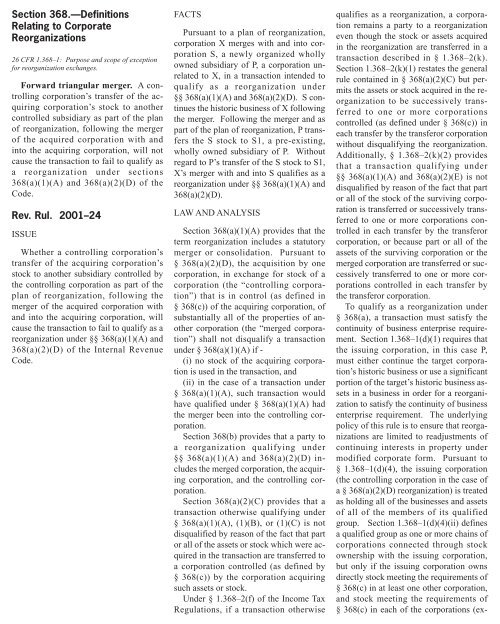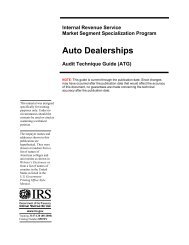Revenue Ruling 2001-24 - Forward triangular merger.
Revenue Ruling 2001-24 - Forward triangular merger.
Revenue Ruling 2001-24 - Forward triangular merger.
Create successful ePaper yourself
Turn your PDF publications into a flip-book with our unique Google optimized e-Paper software.
Section 368.—Definitions<br />
Relating to Corporate<br />
Reorganizations<br />
26 CFR 1.368–1: Purpose and scope of exception<br />
for reorganization exchanges.<br />
<strong>Forward</strong> <strong>triangular</strong> <strong>merger</strong>. A controlling<br />
corporation’s transfer of the acquiring<br />
corporation’s stock to another<br />
controlled subsidiary as part of the plan<br />
of reorganization, following the <strong>merger</strong><br />
of the acquired corporation with and<br />
into the acquiring corporation, will not<br />
cause the transaction to fail to qualify as<br />
a reorganization under sections<br />
368(a)(1)(A) and 368(a)(2)(D) of the<br />
Code.<br />
Rev. Rul. <strong>2001</strong>–<strong>24</strong><br />
ISSUE<br />
Whether a controlling corporation’s<br />
transfer of the acquiring corporation’s<br />
stock to another subsidiary controlled by<br />
the controlling corporation as part of the<br />
plan of reorganization, following the<br />
<strong>merger</strong> of the acquired corporation with<br />
and into the acquiring corporation, will<br />
cause the transaction to fail to qualify as a<br />
reorganization under §§ 368(a)(1)(A) and<br />
368(a)(2)(D) of the Internal <strong>Revenue</strong><br />
Code.<br />
FACTS<br />
Pursuant to a plan of reorganization,<br />
corporation X merges with and into corporation<br />
S, a newly organized wholly<br />
owned subsidiary of P, a corporation unrelated<br />
to X, in a transaction intended to<br />
qualify as a reorganization under<br />
§§ 368(a)(1)(A) and 368(a)(2)(D). S continues<br />
the historic business of X following<br />
the <strong>merger</strong>. Following the <strong>merger</strong> and as<br />
part of the plan of reorganization, P transfers<br />
the S stock to S1, a pre-existing,<br />
wholly owned subsidiary of P. Without<br />
regard to P’s transfer of the S stock to S1,<br />
X’s <strong>merger</strong> with and into S qualifies as a<br />
reorganization under §§ 368(a)(1)(A) and<br />
368(a)(2)(D).<br />
LAW AND ANALYSIS<br />
Section 368(a)(1)(A) provides that the<br />
term reorganization includes a statutory<br />
<strong>merger</strong> or consolidation. Pursuant to<br />
§ 368(a)(2)(D), the acquisition by one<br />
corporation, in exchange for stock of a<br />
corporation (the “controlling corporation”)<br />
that is in control (as defined in<br />
§ 368(c)) of the acquiring corporation, of<br />
substantially all of the properties of another<br />
corporation (the “merged corporation”)<br />
shall not disqualify a transaction<br />
under § 368(a)(1)(A) if -<br />
(i) no stock of the acquiring corporation<br />
is used in the transaction, and<br />
(ii) in the case of a transaction under<br />
§ 368(a)(1)(A), such transaction would<br />
have qualified under § 368(a)(1)(A) had<br />
the <strong>merger</strong> been into the controlling corporation.<br />
Section 368(b) provides that a party to<br />
a reorganization qualifying under<br />
§§ 368(a)(1)(A) and 368(a)(2)(D) includes<br />
the merged corporation, the acquiring<br />
corporation, and the controlling corporation.<br />
Section 368(a)(2)(C) provides that a<br />
transaction otherwise qualifying under<br />
§ 368(a)(1)(A), (1)(B), or (1)(C) is not<br />
disqualified by reason of the fact that part<br />
or all of the assets or stock which were acquired<br />
in the transaction are transferred to<br />
a corporation controlled (as defined by<br />
§ 368(c)) by the corporation acquiring<br />
such assets or stock.<br />
Under § 1.368–2(f) of the Income Tax<br />
Regulations, if a transaction otherwise<br />
qualifies as a reorganization, a corporation<br />
remains a party to a reorganization<br />
even though the stock or assets acquired<br />
in the reorganization are transferred in a<br />
transaction described in § 1.368–2(k).<br />
Section 1.368–2(k)(1) restates the general<br />
rule contained in § 368(a)(2)(C) but permits<br />
the assets or stock acquired in the reorganization<br />
to be successively transferred<br />
to one or more corporations<br />
controlled (as defined under § 368(c)) in<br />
each transfer by the transferor corporation<br />
without disqualifying the reorganization.<br />
Additionally, § 1.368–2(k)(2) provides<br />
that a transaction qualifying under<br />
§§ 368(a)(1)(A) and 368(a)(2)(E) is not<br />
disqualified by reason of the fact that part<br />
or all of the stock of the surviving corporation<br />
is transferred or successively transferred<br />
to one or more corporations controlled<br />
in each transfer by the transferor<br />
corporation, or because part or all of the<br />
assets of the surviving corporation or the<br />
merged corporation are transferred or successively<br />
transferred to one or more corporations<br />
controlled in each transfer by<br />
the transferor corporation.<br />
To qualify as a reorganization under<br />
§ 368(a), a transaction must satisfy the<br />
continuity of business enterprise requirement.<br />
Section 1.368–1(d)(1) requires that<br />
the issuing corporation, in this case P,<br />
must either continue the target corporation’s<br />
historic business or use a significant<br />
portion of the target’s historic business assets<br />
in a business in order for a reorganization<br />
to satisfy the continuity of business<br />
enterprise requirement. The underlying<br />
policy of this rule is to ensure that reorganizations<br />
are limited to readjustments of<br />
continuing interests in property under<br />
modified corporate form. Pursuant to<br />
§ 1.368–1(d)(4), the issuing corporation<br />
(the controlling corporation in the case of<br />
a § 368(a)(2)(D) reorganization) is treated<br />
as holding all of the businesses and assets<br />
of all of the members of its qualified<br />
group. Section 1.368–1(d)(4)(ii) defines<br />
a qualified group as one or more chains of<br />
corporations connected through stock<br />
ownership with the issuing corporation,<br />
but only if the issuing corporation owns<br />
directly stock meeting the requirements of<br />
§ 368(c) in at least one other corporation,<br />
and stock meeting the requirements of<br />
§ 368(c) in each of the corporations (ex-
cept the issuing corporation) is owned directly<br />
by one of the other corporations.<br />
Therefore, the issuing corporation is<br />
treated as directly holding the businesses<br />
and assets of second-tier and lower-tier<br />
subsidiaries that are part of the qualified<br />
group.<br />
In applying these requirements to the<br />
facts, the continuity of business enterprise<br />
requirement is satisfied. Because S and<br />
S1 are members of P’s qualified group, P<br />
will be treated as directly holding the<br />
businesses and assets of S. Therefore, because<br />
S will continue X’s historic business<br />
following the <strong>merger</strong>, the transaction<br />
will satisfy the continuity of business enterprise<br />
requirement of § 1.368–1(d).<br />
The remaining issue is whether P’s<br />
transfer of the S stock to S1 as part of the<br />
plan of reorganization causes P to fail to<br />
control S for purposes of § 368(a)(2)(D)<br />
and causes P to fail to be a party to the reorganization.<br />
Section 368(a)(2)(C) and<br />
§ 1.368–2(k) do not specifically address<br />
P’s transfer of the stock of S to S1 following<br />
an otherwise qualifying reorganization<br />
under §§ 368(a)(1)(A) and<br />
368(a)(2)(D), because assets and not<br />
stock were acquired in the reorganization.<br />
If the transaction were recast under<br />
the step transaction doctrine so that X’s<br />
assets were viewed as being acquired by<br />
a second-tier subsidiary of P, the transaction<br />
would not qualify as a reorganization<br />
under §§ 368(a)(1)(A) and 368(a)(2)(D)<br />
because P would not control S. For the<br />
reasons set forth below, the transaction<br />
will not be recast under the step transaction<br />
doctrine.<br />
The legislative history of § 368(a)<br />
(2)(E) suggests that forward and reverse<br />
<strong>triangular</strong> <strong>merger</strong>s should be treated similarly.<br />
See S. Rep. No. 1533, 91st Cong.,<br />
2d Sess. 2 (1970). As discussed above,<br />
pursuant to § 1.368–2(k)(2), a controlling<br />
corporation in a <strong>merger</strong> that qualifies<br />
under §§ 368(a)(1)(A) and 368(a)(2)(E)<br />
may transfer the stock (or assets) of the<br />
surviving corporation to a controlled subsidiary<br />
without causing the transaction to<br />
fail to qualify as a reorganization under<br />
§§ 368(a)(1)(A) and 368(a)(2)(E). The<br />
concept that forward and reverse <strong>triangular</strong><br />
<strong>merger</strong>s should be treated similarly<br />
supports permitting P to transfer the S<br />
stock to S1 without causing the transaction<br />
to fail to qualify as a reorganization<br />
under §§ 368(a)(1)(A) and 368(a)(2)(D).<br />
This concept also is reflected in the continuity<br />
of business enterprise regulations<br />
under § 1.368–1(d), which do not distinguish<br />
between § 368(a)(2)(D) and<br />
§ 368(a)(2)(E) reorganizations and do not<br />
differentiate between whether stock or<br />
assets are acquired.<br />
Section 368(a)(2)(C) does not preclude<br />
this transaction from qualifying as a reorganization<br />
under §§ 368(a)(1)(A) and<br />
368(a)(2)(D) because of the stock transfer.<br />
By its terms, § 368(a)(2)(C) is a permissive<br />
rather than an exclusive or restrictive<br />
section. See, e.g., § 1.368–2(k);<br />
Rev. Rul. 64–73, 1964–1 C.B. 142. Further,<br />
§ 368(a)(2)(C) and § 1.368–2(k)<br />
similarly do not cause P to fail to be<br />
treated as a party to the reorganization.<br />
See Rev. Rul. 64–73.<br />
Accordingly, for the reasons set forth<br />
above, P’s transfer of the S stock to S1 as<br />
part of the plan of reorganization, following<br />
the <strong>merger</strong> of X with and into S, will<br />
not cause P to be treated as not in control<br />
of S for purposes of § 368(a)(2)(D). Additionally,<br />
P will be treated as a party to<br />
the reorganization.<br />
HOLDING<br />
A controlling corporation’s transfer of<br />
the acquiring corporation’s stock to a subsidiary<br />
controlled by the controlling corporation<br />
as part of the plan of reorganization,<br />
following the <strong>merger</strong> of the acquired<br />
corporation with and into the acquiring<br />
corporation, will not cause the transaction<br />
to fail to qualify as a reorganization under<br />
§§ 368(a)(1)(A) and 368(a)(2)(D).<br />
DRAFTING INFORMATION<br />
The principal authors of this revenue<br />
ruling are Joseph Calianno and Marnie<br />
Rapaport of the Office of Associate Chief<br />
Counsel (Corporate). For further information<br />
regarding this revenue ruling, contact<br />
Mr. Calianno at (202) 622-7930 or<br />
Ms. Rapaport at (202) 622-7550 (not a<br />
toll-free call).<br />
26 CFR 1.368–1: Purpose and scope of exception<br />
of reorganization exchanges.<br />
Reverse <strong>triangular</strong> <strong>merger</strong>. A reverse<br />
<strong>triangular</strong> <strong>merger</strong> qualifies as a tax-free<br />
reorganization under sections 368(a)<br />
(1)(A) and 368(a)(2)(E) of the Code,<br />
notwithstanding that immediately after<br />
the <strong>merger</strong>, and as part of a plan that includes<br />
the <strong>merger</strong>, the surviving corporation<br />
sells a portion of its assets to an unrelated<br />
party for cash that it retains.
















